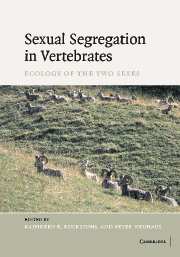Book contents
- Frontmatter
- Contents
- List of contributors
- Preface
- Part I Overview
- Part II Concepts and methodology
- Part III Foraging ecology
- 3 Sex differences in the foraging ecology of large mammalian herbivores
- 4 Sexual segregation in seals
- 5 Sexual differences in foraging behaviour and diets: a case study of wandering albatrosses
- 6 Differences in foraging behaviour and feeding ecology in giant petrels
- Part IV Predator avoidance and reproductive strategies
- Part V Sex-related activities and social factors
- Part VI Sexual differences in ecology: comparisons within different taxa
- Part VII Implications for conservation
- Part VIII Outlook
- References
- Index
3 - Sex differences in the foraging ecology of large mammalian herbivores
Published online by Cambridge University Press: 04 September 2009
- Frontmatter
- Contents
- List of contributors
- Preface
- Part I Overview
- Part II Concepts and methodology
- Part III Foraging ecology
- 3 Sex differences in the foraging ecology of large mammalian herbivores
- 4 Sexual segregation in seals
- 5 Sexual differences in foraging behaviour and diets: a case study of wandering albatrosses
- 6 Differences in foraging behaviour and feeding ecology in giant petrels
- Part IV Predator avoidance and reproductive strategies
- Part V Sex-related activities and social factors
- Part VI Sexual differences in ecology: comparisons within different taxa
- Part VII Implications for conservation
- Part VIII Outlook
- References
- Index
Summary
INTRODUCTION
Adult males and females of many animal species differ in terms of the taxonomic range of food types they use, and/or the physical and chemical properties of the meals they ingest. Surprisingly, however, recognition and understanding of these differences has advanced slowly. For example, practitioners of wildlife production and conservation typically use total animal numbers for setting stocking rates, estimating area requirements, monitoring plant–animal interactions, etc., with no consideration of sex differences in feeding ecology. Yet the reason why textbooks on wildlife ecology and management (e.g. Caughley & Sinclair, 1994) seldom address sex differences is more the lack of conclusive published information than simple oversight. Hence, my purpose in writing this chapter will be served if it stimulates further research on this ecologically important topic.
My focus here is on sex differences in the foraging ecology of large mammalian herbivores (>5 kg), mostly because the principles underlying diet selection have been better studied in this group than in any other. It is obvious that substantial dietary differences will occur when male and female herbivores feed in separate plant communities, the possible reasons for which are discussed in Chapter 9. Here, however, I discuss sex differences in the consumption of plant material by large herbivores at the scale of the small patch, or feeding station (as defined by Senft et al., 1987).
- Type
- Chapter
- Information
- Sexual Segregation in Vertebrates , pp. 35 - 52Publisher: Cambridge University PressPrint publication year: 2006
- 8
- Cited by



